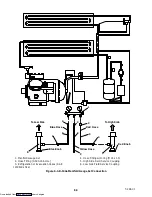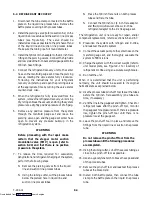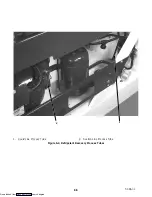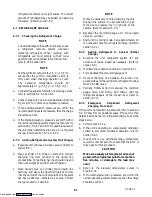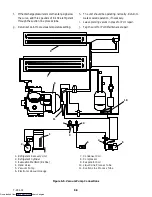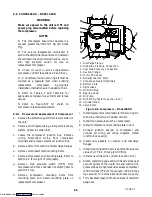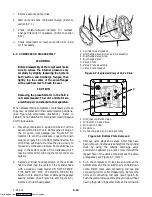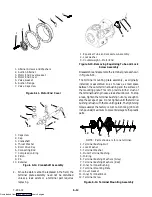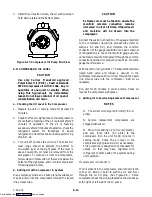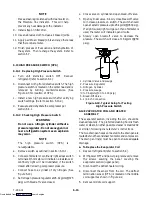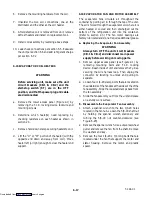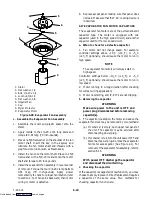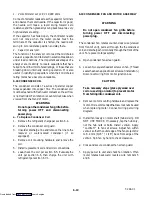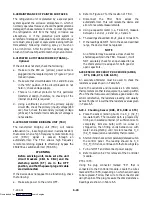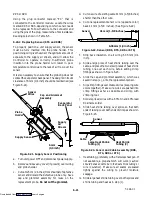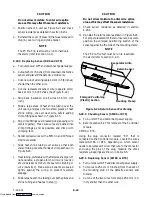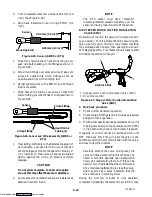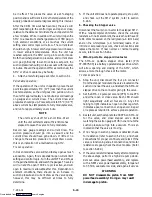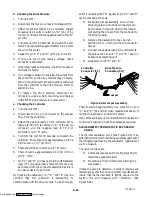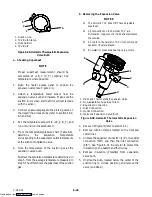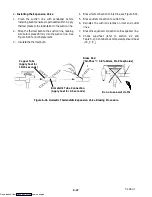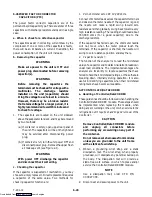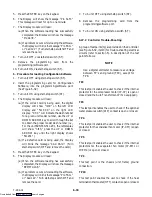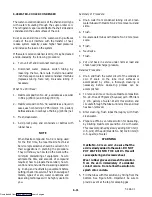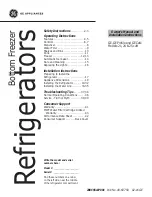
6-16
T-294-01
NOTE
Place a clean rag moistened with clean water on
the Moisture line indicator. This will help
prevent any heat damage to the indicator.
9. Install strap on filter drier.
10. Use an abrasive cloth to clean all brazed joints.
11. Apply paint to all brazed joints and any other areas
that there is bare metal.
12. Finish process of Evacuation and Dehydration of
the system. Then recharge the system. Refer to
section 6.7.
6.13 HIGH PRESSURE SWITCH (HPS)
6.13.1 Replacing High Pressure Switch
a. Turn unit start-stop switch OFF. Recover
refrigerant (refer to section 6.4).
b. Disconnect wiring from defective switch. The high
pressure switch is located on the center head and is
removed by turning counterclockwise. (See
Figure 2-3 for location of HPS.)
c. Install a new high pressure switch after verifying
switch settings. (Refer to section 6.13.2.)
d. Evacuate and dehydrate the compressor per
section 6.6.1.
6.13.2 Checking High Pressure Switch
WARNING
Do not use a nitrogen cylinder without a
pressure regulator. Do not use oxygen in or
near a refrigeration system as an explosion
may occur.
NOTE
The
high
pressure
switch
(HPS)
is
non-adjustable.
a. Remove switch as outlined in section 6.13.1.
b. Connect ohmmeter or continuity light across switch
terminals. Ohm meter will indicate no resistance or
continuity light will be illuminated if the switch
closed after relieving compressor pressure.
c. Connect hose to a cylinder of dry nitrogen. (See
Figure 6-19.)
d. Set nitrogen pressure regulator at 26.4 kg/cm
@
(375
psig) with bleed-off valve closed.
e. Close valve on cylinder and open bleed-off valve.
f. Open cylinder valve. Slowly close bleed-off valve
to increase pressure on switch. The switch should
open at a static pressure up to 25 kg/cm
@
(350 psig).
If a light is used, light will go out. If an ohmmeter is
used, the meter will indicate open circuits.
g. Slowly open bleed-off valve to decrease the
pressure. The switch will close at 18 kg/cm
@
(250
psig).
1
2
3
4
5
6
1. Cylinder Valve and Gauge
2. Pressure Regulator
3. Nitrogen Cylinder
4. Pressure Gauge
(0 to 36 kg/cm
@
= 0 to 400 psig)
5. Bleed-Off Valve
6. 1/4 inch Connection
Figure 6-19. Typical Setup for Testing
High Pressure Switch
6.14 EVAPORATOR COIL AND HEATER
ASSEMBLY
The evaporator section, including the coil, should be
cleaned regularly. The preferred cleaning fluid is fresh
water or steam. Another possible cleaner is Oakite 202
or similar, following
manufacturer’s instructions.
The two drain pan hoses connected to the drain pan are
routed behind the condenser fan motor and compressor.
The drain pan line(s) must be open to ensure adequate
drainage.
a.
To Replace the Evaporator Coil
1. Recover refrigerant (refer to section 6.4).
2. With power OFF and power plug removed, remove
the screws securing the panel covering the
evaporator section (upper panel).
3. Disconnect the defrost heater wiring.
4. Disconnect the sensor from the coil. The defrost
termination sensor (DTS) is located on the middle
coil support as shown in Figure 2-2.
5. Remove middle coil support.
Downloaded from


